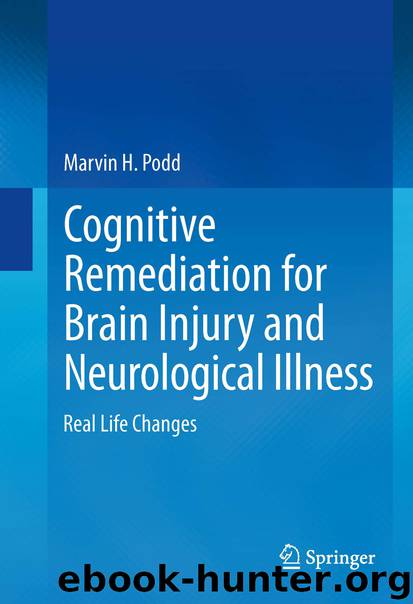Cognitive Remediation for Brain Injury and Neurological Illness by Marvin H. Podd

Author:Marvin H. Podd
Language: eng
Format: epub
Publisher: Springer New York, New York, NY
Blast Injury Symptoms and Mechanisms
The mechanisms involved in blast injury to the brain are thought to be quite different from the acceleration/deceleration mechanism discussed in the head trauma section. Some hypotheses include overpressure and shock waves. Neurological and cognitive effects of blast injuries have not yet been characterized in the research literature. However, the following represents my clinical experience with this population. In the acute phase most patients exposed to blasts “appear” to have no cognitive deficits and interact relatively normally with their doctors. However, formal neuropsychological testing reveals that a portion of them perform abnormally, especially in the areas of visual–spatial functioning and word generation. Some also show deficits in memory, attention, and executive functioning. These observations are similar to those in the composite examples of blast injured individuals reported by French et al. (2010). Many show significant improvement over the next few months but some do not fully recover without intervention. The cases reviewed herein suggested that the mildly impaired patients with postacute residual cognitive problems responded well to cognitive remediation and were able to make significant improvement in their daily lives. Problems that persisted into the postacute phase were visual but not auditory attention, processing speed, and executive functions, including multitasking. SP was by all definitions severely impaired, with 1 month loss of consciousness and significant retrograde amnesia. He also had a complicated picture that included embedded schrapnel and multiple neurosurgeries in addition to blast exposure, PTSD, and pain. Nonetheless, he made great strides in his ability to interact, develop a relationship and follow through with treatment recommendations. These real-life changes were in contrast to his failure to show meaningful improvements on the neuropsychological measures and raised questions about the interfering role of PTSD and pain when neurological functioning had perhaps shown some improvement. All of the above cases had factors that complicated the picture of blast injury, including physical and psychological problems, possible secondary gain, and more than one type of neurological mechanism of injury (e.g., blast plus PTSD and pain, HUMVEE rollover, or blunt head injury). Therefore, it is more difficult to separate the blast effects from the effects of the concomitant problems. A similar conclusion was drawn by MacDonald et al. (2011) who found multiple mechanisms of injury in the blast-exposed soldiers they evaluated.
Download
This site does not store any files on its server. We only index and link to content provided by other sites. Please contact the content providers to delete copyright contents if any and email us, we'll remove relevant links or contents immediately.
Periodization Training for Sports by Tudor Bompa(8094)
Bodyweight Strength Training by Jay Cardiello(7795)
Born to Run: by Christopher McDougall(7024)
Inner Engineering: A Yogi's Guide to Joy by Sadhguru(6630)
Asking the Right Questions: A Guide to Critical Thinking by M. Neil Browne & Stuart M. Keeley(5572)
The Fat Loss Plan by Joe Wicks(4751)
Bodyweight Strength Training Anatomy by Bret Contreras(4570)
Yoga Anatomy by Kaminoff Leslie(4243)
Science and Development of Muscle Hypertrophy by Brad Schoenfeld(4056)
Dynamic Alignment Through Imagery by Eric Franklin(4044)
ACSM's Complete Guide to Fitness & Health by ACSM(3934)
The Four-Pack Revolution by Chael Sonnen & Ryan Parsons(3904)
Exercise Technique Manual for Resistance Training by National Strength & Conditioning Association(3904)
Bodyweight Strength Training: 12 Weeks to Build Muscle and Burn Fat by Jay Cardiello(3869)
The Ultimate Bodybuilding Cookbook by Kendall Lou Schmidt(3845)
Yoga Anatomy by Leslie Kaminoff & Amy Matthews(3827)
American Kingpin by Nick Bilton(3707)
Yoga Therapy by Mark Stephens(3664)
Nutrition for Sport, Exercise, and Health by Spano Marie & Kruskall Laura & Thomas D. Travis(3662)
